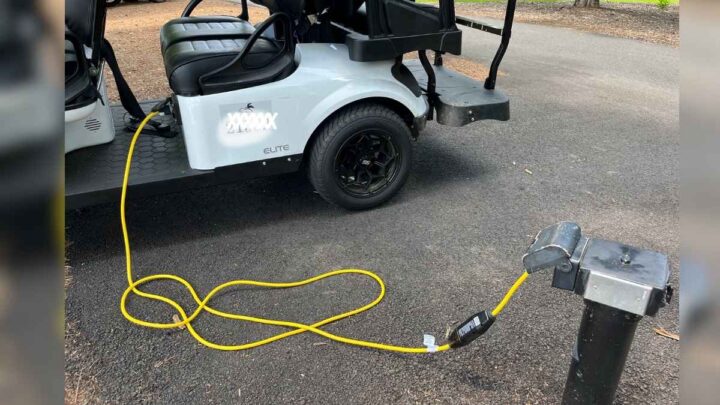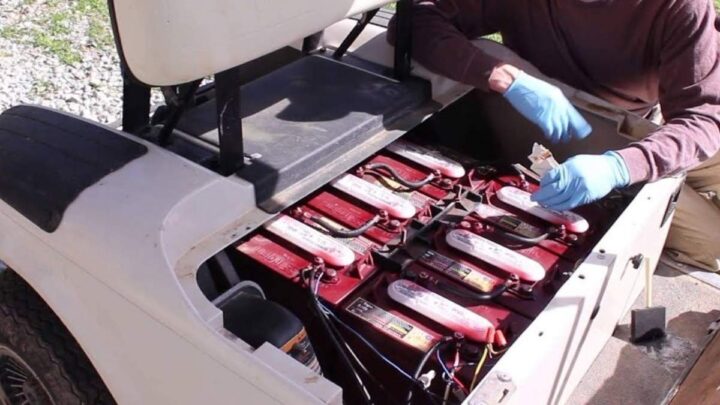How Long Does It Take to Charge a Golf Cart?
How long does it take to charge a golf cart? The answer varies significantly, with charging times ranging from 4 to 14 hours depending on several key factors. A fully charged cart can typically drive between 25 to 40 miles before needing a recharge.

The charging duration largely depends on the battery type. While lead-acid batteries require 10 to 12 hours for a complete charge, lithium batteries charge faster, taking only 4 to 8 hours. In fact, lithium batteries charge twice as fast as traditional lead-acid ones due to their advanced technology and higher current handling capacity.
Power up your golf cart the right way! This guide dives into everything you need to know about charging times—what affects them, how to make your battery last longer, and the best charging habits to keep your ride ready to roll.
How Long Does It Take to Charge a Golf Cart: Basic Timeline
The standard timeline for charging a golf cart varies primarily based on battery type and charging equipment. A completely discharged lead-acid battery typically requires 8 to 12 hours to reach full capacity. Subsequently, lithium batteries demonstrate superior efficiency, achieving a full charge in just 2 to 3 hours.
Standard charging duration
When considering how long does it take a golf cart to charge, the charging duration depends heavily on the remaining battery life. A partially discharged cart might need anywhere from 4 to 14 hours to reach full charge. Additionally, golf cart charging times vary based on voltage ratings – 48V batteries charge faster and provide better range compared to 36V models.
The amperage of the charger plays a crucial role in determining charging speed. Standard chargers, typically rated between 10 to 25 amps, offer different charging durations. For instance, a 20-amp charger can power up a 48V battery in 5-6 hours, whereas a 10-amp charger might take 10-12 hours.
Quick charging options
Modern golf cart charging technology has introduced faster charging solutions. These are commonly available newer golf carts, see what’s available and how much they cost. Fast chargers can reduce standard charging time by up to 50%. Furthermore, smart chargers automatically adjust the charging rate based on battery condition, ensuring optimal charging speed without compromising battery health.
Notable benefits of quick charging solutions include:
- Reduced downtime with charging completed in 3-6 hours
- Automatic transition to trickle charge to prevent overcharging
- Enhanced efficiency for high-usage fleets
- Smart protection systems to safeguard battery life
The charging golf cart batteries process has evolved with technological advancements. Golf cart battery maintenance becomes simpler with smart chargers that can be left plugged in safely, as they automatically switch to maintenance mode once fully charged. How long does it take a golf cart to charge now depends largely on the charging technology chosen, with modern options significantly reducing traditional waiting times.

Key Factors That Affect Golf Cart Charging Time
Several crucial factors determine how long does it take to charge a golf cart. Understanding these elements helps optimize charging efficiency and extend battery life.
Battery type differences
The choice between lead-acid and lithium batteries primarily affects charging golf cart batteries duration. Lead-acid batteries typically require 8-12 hours for a full charge, whereas lithium batteries charge in 2-3 hours. Moreover, lithium batteries maintain consistent charging efficiency throughout their lifespan, delivering 85-100% capacity regardless of discharge rate.
Battery age impact
As golf carts age, their charging time naturally increases. Older batteries take longer to reach full charge because of passive materials building up on electrodes. Generally, lead-acid batteries last between 3-5 years, and their charging efficiency decreases over time. Golf cart charging becomes more time-consuming as these batteries approach the end of their service life.
Weather conditions
Temperature plays a particularly significant role in how long does it take to charge a golf cart. Batteries charge most efficiently at room temperature. Indeed, for every 18°F rise above 77°F, battery life decreases by 50%. During cold weather, the chemical reactions within batteries slow down, leading to:
- Increased internal resistance
- Slower charging rates
- Reduced energy storage capacity
- Higher risk of battery damage
Charger power rating
The charger’s power output notably influences how long does it take a golf cart to charge. A higher-rated charger can significantly reduce charging time. For instance, a 1425W charger completes the process twice as fast as a 650W model. Nonetheless, using the correct voltage rating remains crucial for golf cart battery maintenance and longevity.
Temperature conditions affect charging efficiency primarily during extreme weather. Charging in moderate temperatures ensures optimal performance and prevents potential damage to the battery system. The chemical reactions that generate electricity within batteries slow considerably in cold conditions, making the charging process longer and potentially less effective.
Understanding Your Golf Cart Battery
Understanding golf cart battery specifications helps determine how long does it take to charge a golf cart effectively. A proper grasp of voltage ratings and capacity measurements ensures optimal charging performance.
Voltage ratings explained
Golf cart electrical systems primarily operate on either 36-volt or 48-volt configurations. The voltage setup determines the number of individual batteries needed. A 36-volt system requires six 6-volt batteries, whereas a 48-volt system uses either six 8-volt batteries or eight 6-volt batteries.
For optimal performance, specific voltage readings indicate proper charge levels:
- A 6-volt battery should read 6.3-6.5 volts when fully charged
- An 8-volt battery needs 8.4 volts or higher
- A 12-volt battery requires 12.6 volts for full charge
Battery capacity basics
Battery capacity, essentially measured in ampere-hours (Ah), represents the amount of electric charge a battery can deliver over time. The calculation follows a straightforward formula: Battery Capacity (Ah) = Current (A) × Time (h). Consequently, a battery delivering 10 amperes for 5 hours has a 50 Ah capacity.
How long does it take to charge a golf cart specifically depends on the battery’s amp-hour rating. A higher Ah rating indicates more energy storage and longer running time between charges. For instance, in a 36-volt system, each 6-volt battery should have approximately 200-225Ah for optimal performance.
The actual usable capacity varies based on several factors. Golf cart charging efficiency changes with discharge rates, temperature, and battery age. Altogether, a battery might demonstrate higher capacity at lower discharge rates and reduced capacity during rapid power demands.
Understanding voltage configurations helps in golf cart battery maintenance. For example, a 48-volt system using six 8-volt batteries provides better efficiency than other setups. This configuration enhances battery life and minimizes maintenance requirements while delivering sufficient power for various terrains.
Smart Charging Tips for Golf Cart Owners

Proper charging practices ensure optimal performance and longevity of golf cart batteries. Understanding how long does it take to charge a golf cart becomes crucial for maintaining a reliable power source.
Best time to start charging
The optimal time to charge a golf cart is immediately after use, even if the cart has only been operated for a few minutes. Although many owners wait until batteries are nearly depleted, this practice can damage battery cells. Therefore, charging overnight remains the most effective approach.
Primarily, batteries need a cooling period of 30-60 minutes after operation. This cooling time prevents potential damage from heat buildup during the charging process. How long does it take to charge a golf cart varies based on usage patterns – a partially discharged battery might require 4-14 hours to reach full capacity.
Avoiding common charging mistakes
Understanding how long does it take a golf cart to charge helps prevent critical errors in charging golf cart batteries. Here are the most damaging mistakes to avoid:
- Operating with partially charged batteries reduces capacity and shortens lifespan
- Leaving accessories on while charging drains power unnecessarily
- Using incompatible chargers damages internal battery cells
- Charging in poorly ventilated areas risks hydrogen gas buildup
Golf cart charging requires attention to environmental conditions. Similarly, extreme temperatures affect charging efficiency – cool conditions promote faster charging compared to hot environments. Golf cart battery maintenance includes keeping terminals clean and cables secure.
How long does it take to charge a golf cart also depends on proper equipment usage. An automatic charger prevents overcharging by shutting off when batteries reach full capacity. This feature protects against excessive water loss and plate corrosion, common issues with manual chargers.
For extended storage periods, charge levels should be maintained differently based on battery type. Lead-acid batteries need full charges, whereas lithium batteries should be kept at 40-50% capacity. Regular charging, even during inactive periods, prevents battery degradation.
The charging process benefits from routine inspection of cables and connections. Loose or damaged cables can extend charging time and reduce efficiency. Clean terminals ensure maximum energy flow, ultimately affecting how long the charging process takes.
Charging Different Types of Golf Cart Batteries
Golf cart battery charging processes vary dramatically between different battery types. Understanding these distinctions helps optimize charging efficiency and extend battery life.
How long does it take to charge a golf cart with lead-acid battery
Lead-acid batteries follow a three-stage charging process that typically spans 8-12 hours for a complete charge. Initially, the constant-current stage delivers about 70% charge in 5-8 hours, followed by a topping charge lasting another 7-10 hours. The final float charge maintains the battery at full capacity.
The charging voltage requires precise control, ranging from 2.30V to 2.45V per cell. Temperature plays a crucial role in this process – for every degree above 25°C (77°F), the charging voltage should decrease by 3mV per cell.
Proper maintenance marks the difference between optimal and poor performance. Here are essential care requirements for lead-acid batteries:
- Check water levels monthly, adding distilled water only when fully charged
- Clean terminals regularly using a baking soda solution
- Maintain proper ventilation during charging
- Monitor charging temperature to prevent overheating
How long does it take to charge a golf cart with Lithium battery
In contrast to lead-acid batteries, lithium batteries demonstrate superior charging efficiency. These advanced power units reach full charge in just 2-3 hours, with some models achieving 80% capacity in approximately one hour.
Lithium batteries offer distinct advantages in the charging process. Obviously, they can handle partial charges without damage, unlike lead-acid batteries which suffer from sulfation when partially charged. As a result, golf cart charging becomes more flexible, allowing for convenient top-ups during breaks.
How long does it take to charge a golf cart with lithium batteries primarily depends on the charger’s specifications. These batteries maintain consistent power and speed throughout their discharge cycle, whereas lead-acid batteries experience voltage drops that affect cart performance.
Golf cart battery maintenance for lithium units proves significantly simpler. Certainly, they require no watering and remain maintenance-free throughout their lifespan. In addition to reduced maintenance, lithium batteries typically last five to ten times longer than their lead-acid counterparts.
The charging process benefits from smart charging technology that automatically adjusts parameters based on battery conditions. This advanced feature prevents overcharging while ensuring optimal charge rates, making golf cart charging both safer and more efficient.
How long does it take a golf cart to charge also depends on environmental conditions. The ideal charging temperature range spans from 32°F to 104°F. Operating outside these parameters might affect charging efficiency and battery longevity.
How Long Does It Take To Charge A Golf Cart Frequently Asked Questions
What factors affect the charging time of a golf cart?
Several factors influence charging time, including battery type, age, weather conditions, and charger power rating. Newer batteries and higher-rated chargers generally result in faster charging times.
How can I tell when my golf cart is fully charged?
Most golf carts have an indicator light on the battery compartment. When the light turns green, it typically means the battery is fully charged and ready for use.
What’s the average range of a fully charged golf cart?
On average, a fully charged golf cart can travel between 25 to 40 miles, depending on factors such as battery type, terrain, and driving conditions. Lithium battery carts may achieve even greater ranges. Look into license requirements if driving your golf cart on public roads.
Is it safe to leave my golf cart plugged in all the time?
The answer depends on your battery type. For lithium-ion batteries, it’s generally safe to leave the cart plugged in. However, for lead-acid batteries, it’s best to unplug once fully charged to prevent potential damage.
How long does it take for a golf cart to charge?
A golf cart typically takes 4 to 8 hours to fully charge, depending on factors like battery type, age, and charger capacity. Lithium-ion batteries charge faster, often in 2 to 4 hours, while traditional lead-acid batteries may take longer. Ensuring proper maintenance and using the right charger can help optimize charging time.
How long does it take to charge a 48-volt golf cart?
A 48-volt golf cart usually takes 6 to 10 hours to fully charge, depending on the charger’s amperage and the battery’s health. Using a high-quality charger and avoiding over-discharge can help maintain battery longevity. If the cart has lithium-ion batteries, charging can be completed in 3 to 5 hours, offering quicker turnaround times.


